Fleming 65 Goes 900 Miles to Canal
Tony Fleming's shakedown of a lifetime on his new Fleming 65 now takes him 900 miles
from the Galapagos Islands to the Panama Canal. Along the way we learn about the
failure of some important equipment. We also find out about how much fuel this vessel
is burning and what sort of range is possible. Once in the canal, Tony gives us
a lock-by-lock commentary about what it is like to take one’s pride-and-joy through
this very commercial waterway amongst towering Panamax vessels.
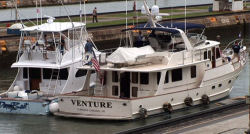
|
|
This 1974 Bertram 46 is for sale for $112,000. A few are even less, and many Bertram 46 are asking about $135,000. |
Read BoatTEST’s
review of the Fleming 65…
On to Panama
We had 900 miles of open ocean ahead of us before arriving at Panama City at the
southern entrance of the famous canal. This was the longest passage any of us had
undertaken in a powerboat and there are of course no ports of refuge between the
destination and the point of departure. In the event we covered the distance in
four days and six hours at an average speed of 8.7 knots burning 1.2 gallons per
mile.
For the most part the weather was fair although we did have one day in which we
had swells and wind-blown waves on the beam which caused us to alter course to make
the ride more comfortable. Honesty causes me to confess that the stabilizers failed
on the outward journey so we had 2,000 miles without their benefits. I should say
that the failure was not the fault of the stabilizers nor of the crew of Tung Hwa
who built the boat but was due to changes made to Venture as she serves her role
as a test bed for trying out new ideas - not all of which, I have to admit, have
been successful. But then, unless we tried we wouldn't know.
However, the innate stability of the Fleming hull kept the ride tolerable although
cooking dinner would have been much more of a challenge without the potholders on
the cooktop. When I see so many boats on the market without them I do wonder how
they get along without them in rough weather. Sandwiches I guess.
Venture has now carried us 15,000 miles - 4,200 of them in the five weeks since
we left the La Paz area on April 12th - and I am writing this latest update as we
await our turn to enter the Panama Canal.
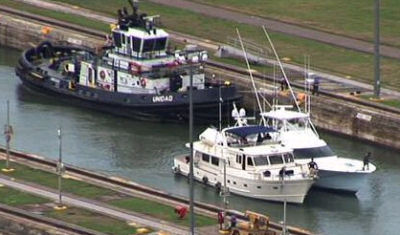
|
Panama At Last
Although our crossing was relatively uneventful our landfall was quite exciting.
It was midnight when we arrived at Punta Mala at the head of the Azuero Peninsula
which forms the western side of Panama Bay. Punta Mala (Bad Point) is a turning
point for ships heading to and from the Panama Canal and, with 40 transits every
24 hours, traffic was heavy around this point with huge Panamax Class container
ships heading in both directions at speeds of up to 26 knots. We were kept on our
toes dodging these behemoths and, on several occasions, we found ourselves within
a mile of ships passing us on both sides heading in opposite directions.
Once we reached the sea buoy at the head of the bay we called Flamenco Signal Station
for permission to proceed to our pre-arranged berth at the Flamenco Marina where
our arrival formalities in Panama and arrangements to transit the canal were greatly
simplified using the services of long established agent, Pete Stevens.
Transiting the Canal
The following day we were visited by an official measurer from ACP - Panama Canal
Authority. She came armed with a tape for checking the length of the boat and a
lengthy questionnaire which included such questions as whether the twin screws rotated
inboard or outboard and the horsepower of the bow thruster.
Small vessels such as Venture are referred to as "handlines" and are subject to
special rules. They must have a whistle or a horn and be capable of at least 8 kts.
Every boat must be equipped with four lines at least 125' long as well as an adequate
number of heavy duty fenders. The lines and fenders - in the form of plastic-wrapped
tires - can be rented. Boats 65' or larger will be provided with a fully-fledged
pilot while smaller boats will have a Transit Advisor. A meal, fresh drinking water
and a decent toilet must be provided. A bucket in the cockpit does not qualify.
The vessel must have substantial cleats and closed chocks so that the lines do not
jump out when the boat is at the bottom of an empty lock.
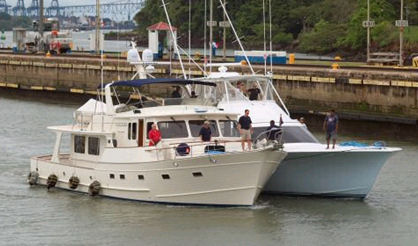
|
Pilot Comes Aboard
Our actual transit was a couple of days later and began with us taking on the pilot
in bumpy sea conditions from a pilot launch just outside the entrance channel. We
were directed under the Bridge of the Americas which, until 2005, carried the only
road linking north and South America. After a short wait in the Balboa basin we
rafted alongside a 55' sports fishing boat and, with Venture providing the motive
power, we slowly moved together into the lower basin of the Miraflores locks. We
were barely inside when the massive lock gates swung closed behind us. Ahead of
us in the same chamber was a bulk carrier from Bangkok. Messenger lines, with a
small but dense monkey-fist on the end, were thrown aboard by line handlers on the
sides of the locks. You need to be paying attention because if struck on the head
you could knocked cold by these fast moving objects. 400
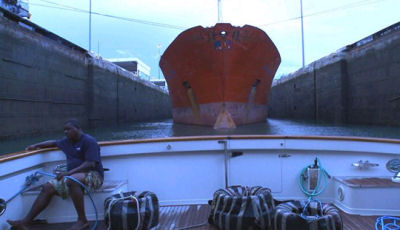
|
Life in the Locks
lines by the crew aboard the boats and then hauled back through the closed chocks
by the line handlers on the lock walls. As the boats moved deeper into the lock
the line handlers walked alongside them and, at the appropriate spot, dropped the
loops over bollards.
A bell sounded and water began to boil up into the lock through culverts in the
floor of the chamber. As the boats rose, the dock lines were progressively shortened
by crewmembers aboard the boats using the cleats as snubbers. The mixing of fresh
and salt water causes extra turbulence in the first and last locks where canal water
meets the sea.
In short order we had risen 27 ft and were now floating above the lock sides. The
forward gate opened and we braced ourselves for the prop wash from the bulk carrier
ahead of us. Vessels larger than 125 ft are held in the center of the lock chambers
by locomotives called mules. They serve only to guide the ships through the locks
and forward motion is provided by the vessel's propulsion system. We moved into
the second chamber and the process was repeated.
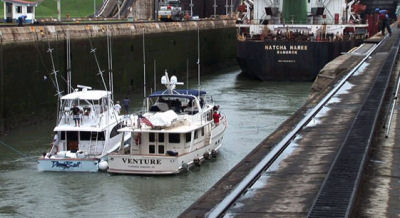
|
We remained rafted to our companion boat for the short length of the Miraflores
Lake to the Pedro Miguel lock with a vertical lift of 31 ft. Here the procedure
was similar except that we had traded the bulk carrier for a canal authority tug.
After exiting this single lock we separated from our neighbor and continued independently
for several miles until we met again late in the afternoon at the Gatun locks for
the descent back to sea level on the Caribbean side of the isthmus.
After leaving the Pedro Miguel lock, the canal passes under the modern Centennial
Bridge, opened in 2005, and passes through the Gaillard Cut. Also known as the Culebra
Cut, this section of the canal slices through the continental divide and was the
source of enormous construction difficulties. Even after it was opened, subsequent
landslides in this area blocked the canal and, in 1915, caused it to be closed for
as long as seven months.
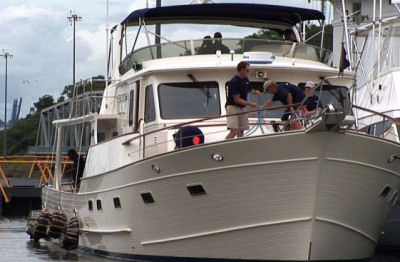
|
Taking a Short Cut
When crossing the expanse of Gatun Lake we took a shortcut through Banana Channel.
This narrow channel is extremely well marked with red and green buoys every 150
ft and beyond its confines can be seen the tops of trees drowned all those years ago when the lake was formed. In places there are small tree-covered islands and
in others the banks are rich with tropical vegetation.
The Gatun locks have three chambers which dropped us back down to sea level. Despite
reports to the contrary, sea levels at the Pacific and Caribbean ends of the canal
vary by no more than 6".
The big difference is that the tidal range at the Pacific
end is 18' (max 22') while at the Caribbean end it is only 3'. In the Gatun locks
we were again rafted to the sportfisher but our lock mates were a tug ahead of us
and a small tanker aft. Painted bright red as if to emphasize the threat, its bow
loomed menacingly over us but at least we did not have to be concerned about the
wash from its propeller.
It had been a long day and dusk was upon us as the final lock gates swung wide and
we headed for the waters of Bahia Limon. Once there the pilot scrambled aboard the
cutter and we headed for the slip at the Panama Canal Yacht Club in Colon. It was
hard to believe that in just one day Venture had crossed the continental divide
from the west to the east coasts of the Americas. Although her course was almost
due north, her arrival point on the Atlantic side lay west of her departure point
on the Pacific coast.
Next: Racing Across the Caribbean
Visit the Fleming Yachts website…